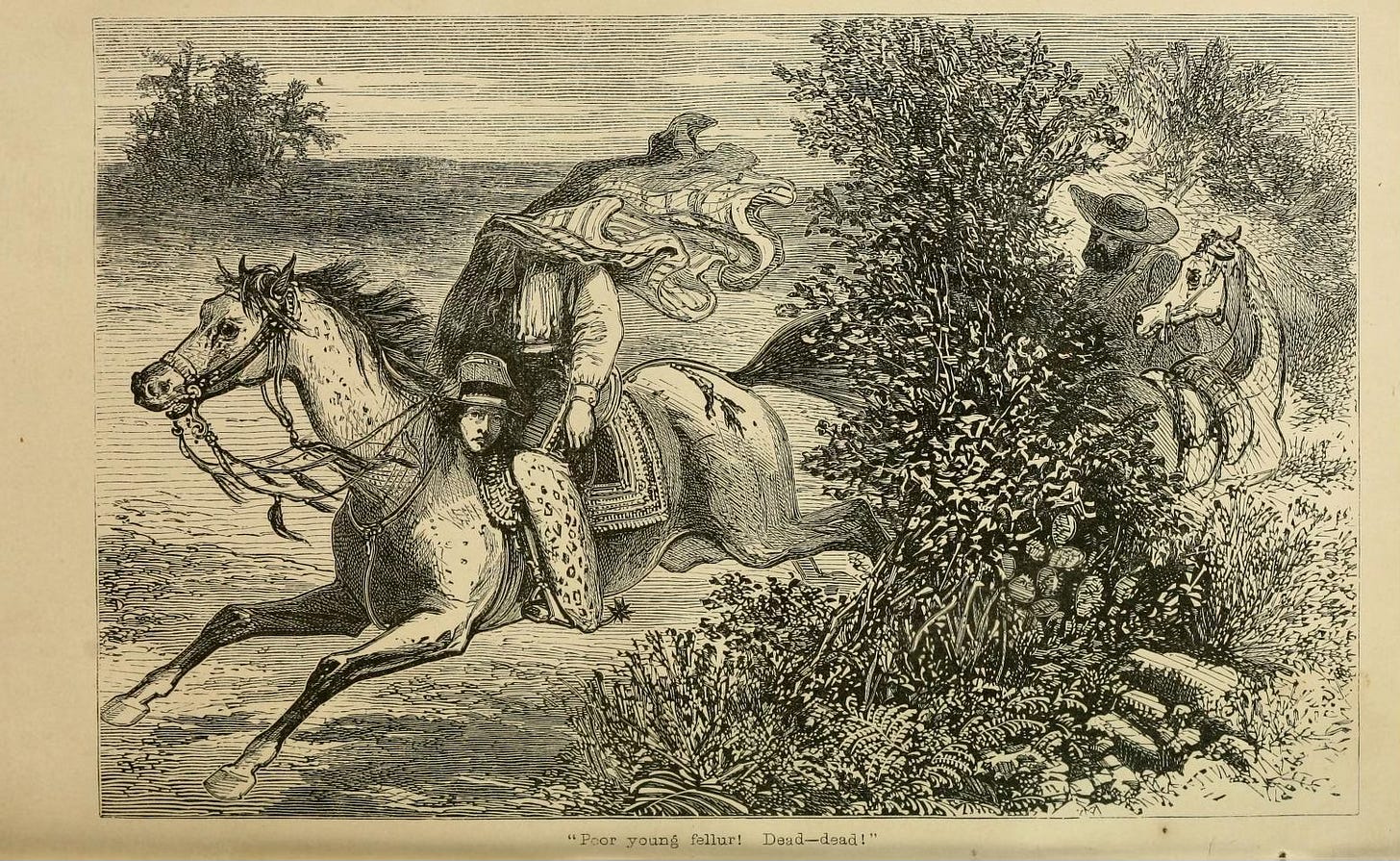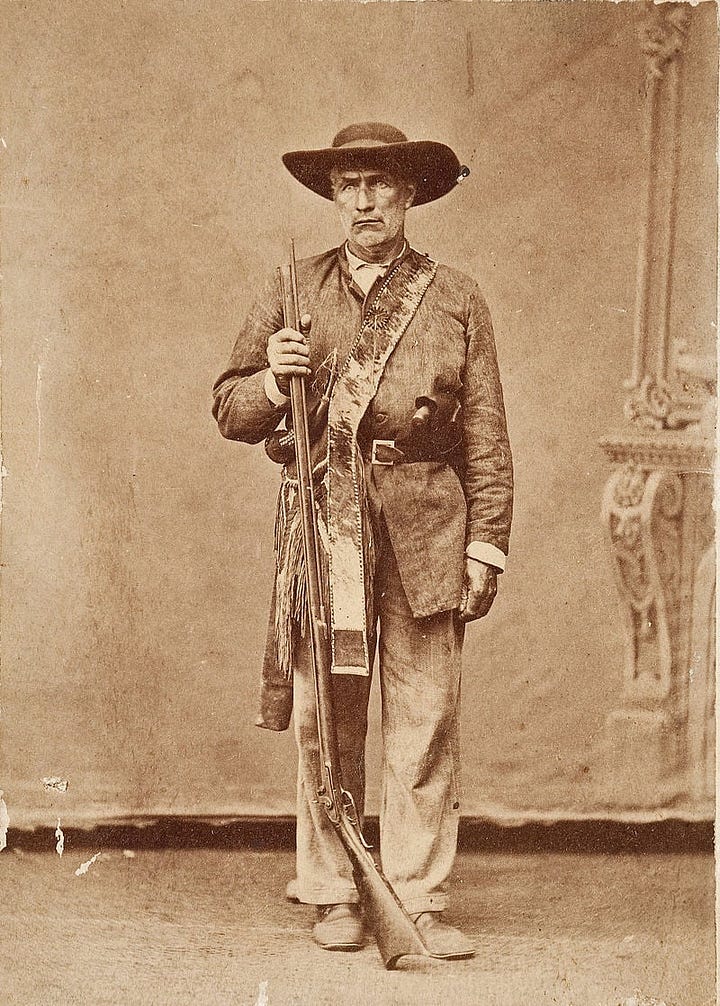The Headless Vaquero
(El Vaquero Sin Cabeza)

Bullets and arrows are useless against the damned and the dead.
Derrick G. Jeter
In the shimmering glare of the Nueces Strip hundreds of hooves pounded the porous earth and flung dust into thermal updrafts. Mustangs, phantasmic and thewy, ran in that brownish haze of dirt and heat, appearing and disappearing at no particular time and place along the range between the rivers Grande and Nueces. On moonless nights thunder and snorts of wild caballos rolled across prickly pear plains. On sunlit mornings ghostly glimpses of blurring colors darted among thorn-stabbed mesquite. Ever trailing, astride a heavy-footed stallion as black as brimstone, was a horseman wrangling these wild herds over the prickled prairie, plunging in and out of chaparral thickets.
Horse and horseman were seen on moon-dimmed nights. Or so the old timers of the Strip used to say. A spectral figure dressed in the manner of a vaquero of old: a bleached buckskinned jacket and gauntlets to match, rawhide leggings ropescarred and splotched with black blood. His tapaderoed boots were heeled with spiked-rowelled spurs. The jingle-bobs of which banged out a dirge when he rode. And when he rode, he neither slouched his spine nor turned in his saddle but sat as rigid as a fence post harpooned to the back of the black beast, his bushtorn serape popping in the windy wake of his steed’s speed and his sombreroed head swinging back and forth in rhythmic meter to his horse’s hooves.
But the head was not upon the vaquero’s shoulders. It rested firmly nestled within its gildedged sombrero, threaded with a rawhide string through its blacken deathclinched jaw and secured to the wide horn of the vaquero’s saddle.
None denied the ghostly trace of the vaquero had been seen in the darkly dusk and dawn of the day. But if hailed, he would not hola. If approached he would not lodge. The creature carrying his scarecrow-like frame would disappear into the shadowy wilderness. Many believed the headless vaquero, El Muerto—the Dead One—was Lucifer incarnate or one of his henchmen bestride a pony of perdition. Some say he carried scales to weigh the souls of the living and the dead as he corralled his hades bound herd.
To rid themselves of their devilish caballero Indians, Mexicans, and Anglos took shots at him, declaring their arrows and bullets had passed through as cleanly as through a paper target. Yet the headless vaquero stayed saddled and rode on, horse and horseman never tiring. Folks in the Strip swore they heard ghastly laughter emanating from the rotting head and guttural sounds otherworldly when it intoned: Bullets and arrows are useless against the damned and the dead.
Ghost stories are not my speciality, but are fun to put a hand to. The story of the Headless Vaquero is my fictional account of what J. Frank Dobie claims to be a historical fact, when in 1850 a Mexican horse thief by the name of Vidal stole a number of horses from Texas Ranger Creed Taylor, along with horses from a rancher by the name of Flores. Taylor and Flores tracked Vidal. At the Frio River they met another Texas Ranger, William A. A. “Bigfoot” Wallace, who joined in the hunt. A few days later, across the Nueces River, the posse came upon Vidal and his gang of horse thieves. When night came, Taylor and Wallace crawled into the camp of the sleeping thieves. Flores was then to shoot the night guard, signaling Taylor and Wallace to dispatch the sleeping men. When morning came, Vidal was among the dead. Wallace then had an idea: they should place Vidal’s corpse on one of the recaptured horses. This is how Dobie described it:
The black mustang was roped, tied up, blindfolded with a red bandanna, saddled with Vidal’s saddle. Then the Texans cut off Vidal’s head and, with chin-stop and thongs, fastened the horse thief’s sombrero firmly to it. Next, making deft use of buckskin, they laced the sombreroed head to the horn of the saddle. It was a Mexican saddle, rawhide-rigged, with a wide, flat horn. They dressed Vidal’s headless body in full regalia—leggins, spurs, serape—and with more care than an arriero in the Sierra Madre takes in packing a mule with silver bars, fixed it in the saddle. They tied the dead man’s feet in the stirrups and doubled-fastened the stirrups to each other under the mustang’s belly so that they could not fly up.
Taylor, Wallace, and Flores then let the mustang loose. While it ran off with the headless vaquero, they drove their horses back to their ranches on the San Antonio River.


J. Frank Dobie, “The Headless Horseman of the Mustangs,” in I’ll Tell You a Tale: An Anthology (Boston: Little, Brown and Company, 1960), 86–93.
Y’allogy is an 1836 percent purebred, open-range guide to the people, places, and past of the great Lone Star. We speak Texan here. Y’alloy is created by a living, breathing Texan—for Texans and lovers of Texas—and is free of charge. I’d be grateful, however, if you’d consider riding for the brand as a paid subscriber and/or purchasing my novel.
Be brave, live free, y’all.



Man, I really enjoyed your picturesque relation of this story. I truly felt I was seeing the whole scene with my own eyes.
I had to look up "tapaderoed."